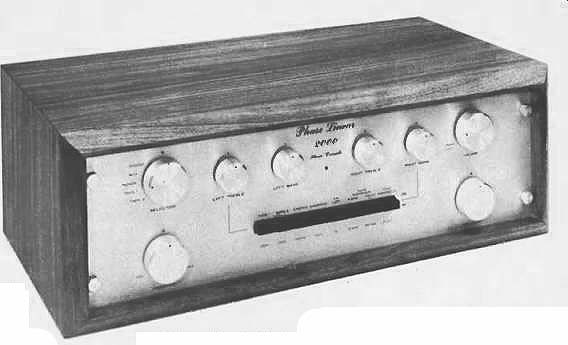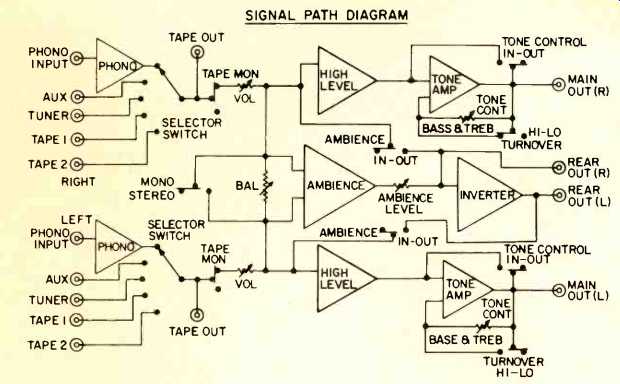
MANUFACTURER'S SPECIFICATIONS:
Rated Output: 2.0 Volts; maximum 10 Volts into 5 kOhm load.
Frequency Response: Phono, RIAA ± 0.5 dB.
Input Impedance: Phono, 47 kOhm, 290 pF; High Level, 40 kOhm.
Input Sensitivity: Phono, 3.2 mV; high level, 350 mV.
Phono Overload: 80 mV.
Gain: Phono, 56 dB at 1 kHz, input to output; high level, 15 dB.
Hum and Noise: Phono, 74 dB below 10 mV input; high level, 88.dB below 2 V output.
Bass Control Range: 50 Hz turnover, ± 11 dB at 20 kHz; 2 kHz turnover, ± 14 dB at 20 kHz.
Dimensions: 19 in. (48.3 cm) W x 5 1/2 in. (14 cm) H x 6 in. (15.2 cm) D.
Weight: 9 lbs. (4.1 kg), less optional wood cabinet.
Suggested Retail Price: $299.00.
Despite what appears to be a great number of controls and buttons on the face of Phase Linear's Model 2000 pre amplifier, it is really quite a "basic" control center with few frills. Aesthetically, the result is a pleasing, symmetrically laid out panel. Controls include a selector switch at the upper left (only one phono position is provided), master volume control at the upper right, balance and "ambience level" controls in the lower corners, smaller centrally located individual bass and treble controls (for each channel), and a tiny power on indicator light just below the model number designation at center-panel. Push button switches along the bottom of the panel take care of the two tape monitor circuits, stereo/mono switching, low frequency EQ (which adds a fixed amount of bass boost below 50 Hz that is independent of any tone or volume control settings), a pair of tone control turnover selector switches, and a tone defeat switch which bypasses tone control circuitry entirely when depressed.
Figure 1 pictures the rear panel layout, which is as comfortably expanded as the front panel arrangement. All out puts are clustered at one end of the panel and include main and "rea" outputs plus the two sets of tape out jacks. Five sets of input jacks include: the two tape-in circuits, tuner, AUX and phono. A chassis ground terminal is provided as are a switched and unswitched a.c. receptacle for auxiliary equipment and a line fuseholder.

(left) Fig. 1--Rear Panel of the Phase Linear 2000. (right) Fig. 2--Internal
view of the chassis.
Internal Construction and Circuitry

Fig. 3--Block Diagram
Internal layout of the chassis is shown in Fig. 2. Total solid state complement of the Model 2000 consists of three ICs, one bi-polar transistor, one bridge rectifier, a Zener regulating diode, and an LED indicator. A single IC is used for the preamp-equalizer circuitry, while a pair of type 4136 ICs are used for tone control and voltage amplification, with a type 4739 IC in conjunction with a bi-polar transistor taking care of the mixing circuitry and phase inversion required for the so-called "ambience" or "rear" outputs which Phase Linear has chosen to incorporate in this preamp. As is evident from the block diagram of Fig. 3, the "ambience" amplifier is simply fed with left and right inputs in such a way as the combine "difference" information with primary left or right channel information. The control labeled "ambience" therefore supplies "rear output" signals which contain vari able amounts of R-L or L-R signals. Such signals, fed to a secondary stereo amplifier (only a basic power amp would be required) and an extra pair of loudspeakers, have been used to create a sense of "hall ambience" in home listening rooms. The effectiveness of the "ambience" system depends in great part upon the types of stereo recordings with which it is used. In our own experience, using recordings that were made "live" (instead of from multi-track studio mix-downs), the random out-of-phase signals fed to the back channel speakers can be quite pleasant if you care for that sort of thing. The additional circuitry required to pull this off probably represents only a small portion of the cost of the Model 2000 and so we cannot fault Phase Linear for departing from the "purist" approach to preamplifier control design.
Laboratory Performance Measurements
At nominal rated output (2.0 volts), THD of the Model 2000 was an almost unmeasurable 0.009% for 1 kHz, 0.02% at 5 volts out and 0.022% at the maximum 10 volt output.
Waveform clipping occurred at an output level of 11.0 volts.
At 20 Hz and 10 kHz respectively, THD for rated output (2.0 volts) measured 0.04% and 0.027%. IM distortion was only 0.01% at 5.0 volts output, increasing to 0.08% at maximum 10 volts out. Phono overload occurred with an input signal of 95 mV, better than the 80 mV claimed, but, in our opinion, a bit on the low side compared with the overload capability of other separate preamps (and even some integrated amps and receivers) currently being produced. Hum and noise in phono was an incredibly good 76 dB below 2.0 volts output with volume adjusted for greatest sensitivity (3.0 mV).
Translated to a 10 mV phono input, the hum and noise figure becomes 86.5 dB, about the best we have ever measured for a phono preamp circuit. In the high level switch position, hum and noise measured 88 dB below 2.0 volts output, as claimed. RIAA equalization was accurate to within 0.4 dB from 30 Hz to 15,000 Hz, and overall frequency response, with tone controls defeated, was flat within 1 dB from 12 Hz to 28,500 Hz.

(left to right): Fig. 4--Range of bass and treble controls when the 50 Hz
and 5 kHz turnovers are used.
Fig. 5--Range of bass and treble controls when the 150 Hz and 2 kHz turnovers are used.
Fig. 6--Response of the Phase Linear with the tone controls set for Flat (lower trace) and with the low frequency EQ button depressed (upper trace).
Figure 4 shows the range of tone control action of bass and treble controls with the turnover points set to 50 Hz and d kHz, while in Fig. 5 tone control range for the more conventional turnover points (150 Hz and 2 kHz) is plotted on our 'scope photo. Using the more extreme turnover points (50 Hz and 5 kHz), as represented in Fig. 4, we see the ad vantage gained by this kind of tone control action in that it becomes possible to compensate for tonal deficiencies at the frequency extremes without altering the essentially flat response of the mid-frequency region.
The two traces in Fig. 6 show the action of the low-frequency EQ circuit, whose boost characteristics is not unlike that obtainable by means of the bass control set to its 50 Hz turnover point.
Use and Listening Tests
The Phase Linear 2000 is easy to install, and the separate controls are a welcome (if mildly extravagant) feature after one is used to dealing with multi-function, dual-concentric, clutch-activated knobs for all these years. Sonically, the 2000 contributes no coloration that we could detect and handles transients and complex musical waveforms with the best of them. The high output levels attainable (with minimal distortion) make it a suitable mate for some of those high-powered amps that lack gain and therefore require inputs well in excess of the 1 volt level (there seem to be more of these around now then ever before). There are preamp/control units on the market which are even more basic (offering even fewer controls) than this one and, conversely, there are some preamps designed for the inveterate knob twirler which have more input and switching facilities than the 2000. Whether or not it has too few or too many inputs, switches, and controls is something you (and I) must judge on the basis of our own needs and taste.
-Leonard Feldman
(Audio magazine, Sept. 1976)
Also see:
Phase Linear 4000 Preamplifier (Nov. 1975)
Phase Linear Model 3000, Series H Preamplifier (Jan. 1979)
Phase Linear 400 Amplifier (Feb. 1973)
Phase Linear 9500 Compact Disc Player (June 1983)
Philips Model AH-572 Preamplifier (Nov. 1977)
= = = =